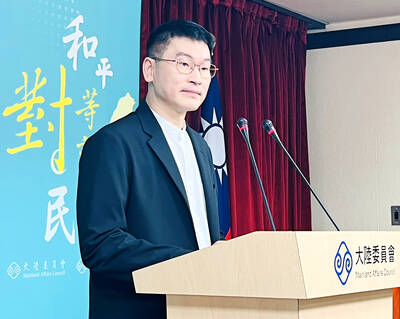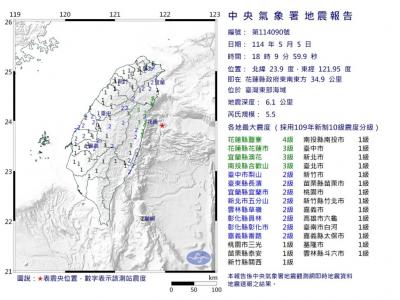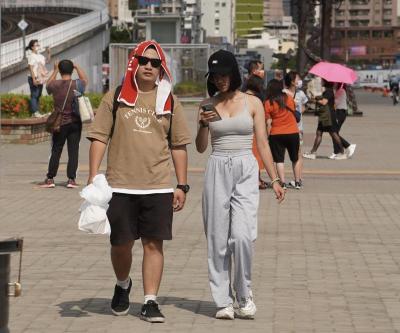Workers on Sept. 20 began restoration work at Tainan’s Tang Te-chang Memorial Park (湯德章紀念公園), with city officials saying they hope the park can fit in better with the surrounding Japanese architecture that dates to the colonial period.
Restoration of the park, which is situated atop the city’s largest traffic circle, is to cost NT$8 million (US$263,713) and take 150 days to complete, at the end of February, the Tainan Cultural Affairs Bureau said.
The bureau said the park is a focal point of urban development efforts due to its important position at the confluence of seven major avenues that spread out to every area of the city. In the park’s immediate vicinity are the Land Bank of Taiwan branch, the Hayashi Department Store, Wude Temple — originally established by the Japanese as the Butokuden, a martial arts center — and other examples of period Japanese architecture.
The park at the south slope of Jiou Ling (鷲嶺) — the city’s highest point — was originally the site of the San Jie altar (三界) built during the Qing Dynasty.
In 1907 local residents erected a statue at the site to commemorate Viscount Kodama Gentaro, a general in the Imperial Japanese Army who became the fourth Governor-General of Taiwan.
Walls surrounding the park came down after the site became a traffic circle under new urban planning designs in 1911.
The park and its surrounding traffic circle were officially named Kodama Park in 1916, but were shortly after renamed Taisho Park after the town, then called Taisho Township (大正町), in which it is situated.
Upon the arrival of the Chinese Nationalist Party (KMT) to Taiwan following World War II, the park was renamed Min Sheng Green Park (民生綠園).
The park was given its current name in 1997 by then-Tainan mayor George Chang (張燦鍙). Chang erected a bust at the section of the traffic circle leading to Zhongshan Road, where lawyer and democracy advocate Tang Te-chang (湯德章) was shot by soldiers during the 228 Incident in 1947.
A statue of Republic of China founder Sun Yat-sen (孫中山) stood in the center of the park until 2014, when it was defaced and torn down by the Alliance of Referendum for Taiwan and its supporters.
In December 2015, artists working in the old Japanese Imperial Army barracks found the original head of the Kodama statue that had long ago been torn down and gone missing.
Research by the bureau found that the bust was made in Italy from gypsum and was imported to Taiwan in 1904. In 1905 it was shipped to Tainan and the statue was erected in 1907. The bureau had the bust restored and put away in storage, saying there are no plans to rebuild the entire body of the statue or re-erect it in Tang Te-chang Memorial Park.
This cultural landmark will be a site for exhibiting artwork once the restoration is completed, bureau Division of Cultural Assets Director Lin Chiao-in (林喬彬) said.

An essay competition jointly organized by a local writing society and a publisher affiliated with the Chinese Communist Party (CCP) might have contravened the Act Governing Relations Between the People of the Taiwan Area and the Mainland Area (臺灣地區與大陸地區人民關係條例), the Mainland Affairs Council (MAC) said on Thursday. “In this case, the partner organization is clearly an agency under the CCP’s Fujian Provincial Committee,” MAC Deputy Minister and spokesperson Liang Wen-chieh (梁文傑) said at a news briefing in Taipei. “It also involves bringing Taiwanese students to China with all-expenses-paid arrangements to attend award ceremonies and camps,” Liang said. Those two “characteristics” are typically sufficient

A magnitude 5.9 earthquake that struck about 33km off the coast of Hualien City was the "main shock" in a series of quakes in the area, with aftershocks expected over the next three days, the Central Weather Administration (CWA) said yesterday. Prior to the magnitude 5.9 quake shaking most of Taiwan at 6:53pm yesterday, six other earthquakes stronger than a magnitude of 4, starting with a magnitude 5.5 quake at 6:09pm, occurred in the area. CWA Seismological Center Director Wu Chien-fu (吳健富) confirmed that the quakes were all part of the same series and that the magnitude 5.5 temblor was

The brilliant blue waters, thick foliage and bucolic atmosphere on this seemingly idyllic archipelago deep in the Pacific Ocean belie the key role it now plays in a titanic geopolitical struggle. Palau is again on the front line as China, and the US and its allies prepare their forces in an intensifying contest for control over the Asia-Pacific region. The democratic nation of just 17,000 people hosts US-controlled airstrips and soon-to-be-completed radar installations that the US military describes as “critical” to monitoring vast swathes of water and airspace. It is also a key piece of the second island chain, a string of

The Central Weather Administration has issued a heat alert for southeastern Taiwan, warning of temperatures as high as 36°C today, while alerting some coastal areas of strong winds later in the day. Kaohsiung’s Neimen District (內門) and Pingtung County’s Neipu Township (內埔) are under an orange heat alert, which warns of temperatures as high as 36°C for three consecutive days, the CWA said, citing southwest winds. The heat would also extend to Tainan’s Nansi (楠西) and Yujing (玉井) districts, as well as Pingtung’s Gaoshu (高樹), Yanpu (鹽埔) and Majia (瑪家) townships, it said, forecasting highs of up to 36°C in those areas